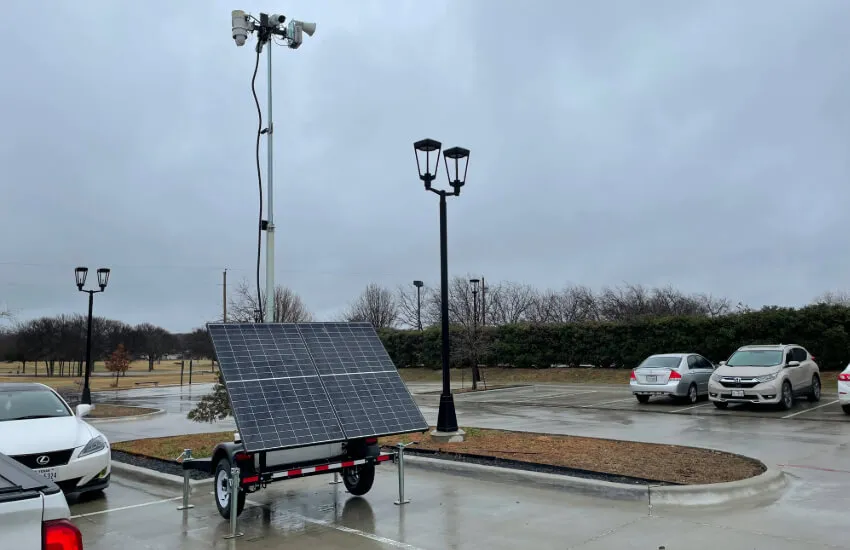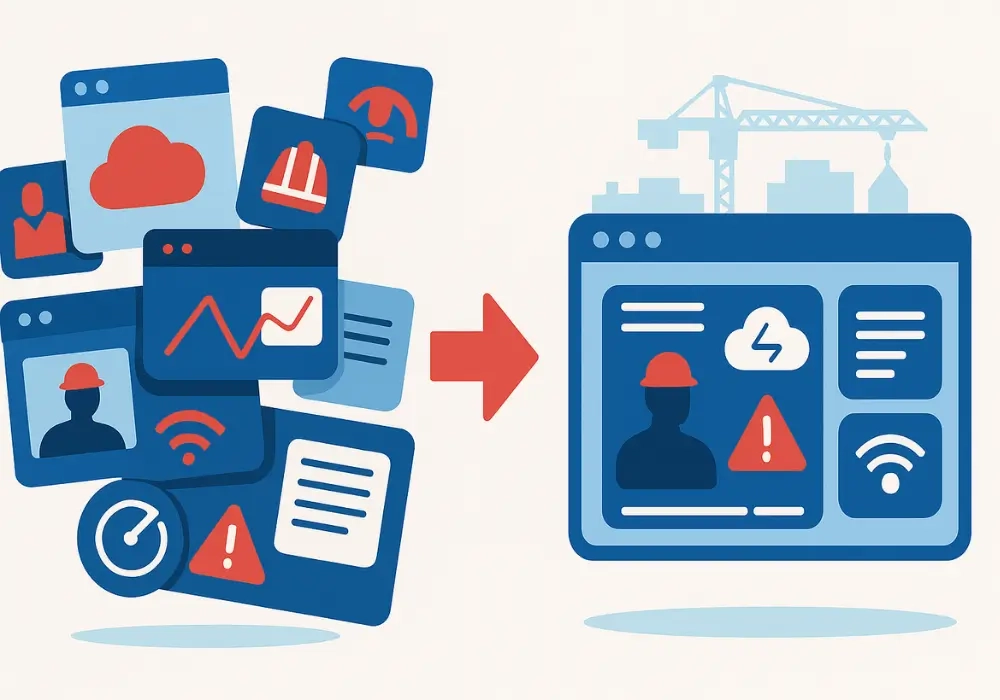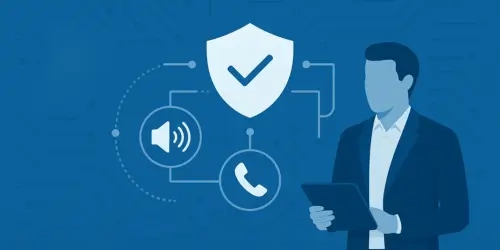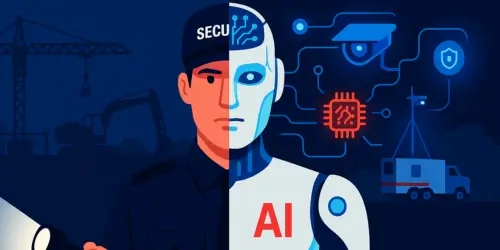Managing multiple IT systems across construction jobsites is no easy feat. Site managers need different tools to track various equipment, monitor network performance, oversee project data, and keep field operations running without interruption.
The problem is that most of these systems operate independently and can't communicate with each other, making it easy for critical issues to go unnoticed till they cause problems.
The result of this scattered approach is wasted time, duplicated effort, and increased operational costs. Construction managers spend too much time switching between platforms and compiling reports, instead of focusing on strategic improvements or supporting field staff.
Consolidated monitoring offers a better solution by unifying your software tools into a single platform that provides complete visibility across all jobsites.
In this article, we'll explore how vendor sprawl develops in construction IT, why it creates inefficiencies and risks, and how vendor consolidation can improve oversight, cut costs, streamline operations, and deliver clearer insights.
What Vendor Sprawl Looks Like in Construction IT
Vendor and tool sprawl in construction IT happens when organizations rely on too many fragmented tools and systems across their jobsites. Each department or project team may use multiple platforms for tracking equipment, managing project schedules, handling field communications, and monitoring networks.
Here's what vendor sprawl looks like in action:
-
Multiple interfaces and dashboards: Instead of a unified platform, IT teams need to log into multiple systems to access information, making it difficult to see the complete picture of operations.
-
Fragmented data: Critical information is scattered across different monitoring tools, which slows down your decision-making process and increases the risk of errors.
-
Overlapping functionality: Teams often pay for multiple tools that perform similar tasks, increasing the financial burden for licensing fees.
-
Slow response times: When alerts and notifications are scattered, it can take longer for your security teams to detect and resolve issues on jobsites.
-
Compliance and security gaps: Disconnected systems make it harder to monitor site access, track changes, enforce policies, and maintain regulatory compliance across multiple projects.
The Cost of Vendor Sprawl in the Construction Industry
Vendor sprawl has a real business impact. Below are 5 ways it affects your business continuity:
-
Time costs and operational inefficiencies: Dealing with fragmented systems often forces your team to waste hours on basic admin work, such as logging into existing systems and bouncing between redundant tools that don't offer any real value. After that, you still have to pull reports and compile them for analysis manually. This valuable time could be better spent on more high-value tasks.
-
Higher licensing fees: Monitoring tools are anything but cheap, and paying for different systems that provide the same functionality quickly adds up. These costs may seem negligible at first, but as the number of tools in your tech stack increases, the financial impact grows and can end up eating into your bottom line.
-
Increased support and maintenance costs: Managing multiple vendors for your jobsite operations can get complicated fast, since each system operates differently and requires a unique troubleshooting approach. Your teams need to learn various interfaces, maintain different update schedules, and gain expertise across several platforms, which drives up labor costs and creates dependencies on specialized knowledge that can be difficult to replace when key personnel leave.
-
Security blind spots: More tools mean more processes, which makes it harder to detect more room for jobsite security risks, especially when you're managing various jobsites simultaneously. Each tool comes with its own alerting mechanisms, access controls, risk assessments, and reporting standards, impacting your overall construction jobsite security. Cybercriminals can exploit these weak points and cause serious damage to your operations.
-
Compliance risks. Jobsites must comply with many regulations and safety standards, including the OSHA Construction Standards (29 CFR 1926) and Hazard Communication (HazCom) Standard. Fragmented systems make this harder to do, and failure to comply can lead to serious consequences. For example, a construction contractor from Illinois was fined $264,143 for not protecting his employees from deadly fall hazards.
Read more: The Hidden Costs of Legacy Systems on Modern Construction Jobsites
Why Consolidated Monitoring Matters for US Construction IT
Moving from multiple disconnected tools to an integrated platform simplifies operations and delivers measurable benefits that directly impact your project profitability.
Improved efficiency
Consolidating vendors means reduced complexity. You no longer need to log in to different platforms, toggle between multiple dashboards, and manually compile siloed data. Centralizing all the required information allows you to make decisions and respond to issues faster. Also, using a single, reliable platform eliminates the need for site visits to check on critical infrastructure and systems.
Better compliance tracking
Application consolidation makes it easier to understand the compliance status of all your projects. With fewer tools and all data in one place, you can quickly see which jobsite needs urgent attention and how to stay updated with relevant regulations.
Fewer vendors to manage
Managing vendors is/can be time-consuming, since you have to track various subscriptions and navigate different vendor relationships. There's also the ongoing challenge of onboarding and training your team to use these tools. All of this becomes a thing of the past once you consolidate your technology stack into a unified platform.
Stronger jobsite visibility and reduced risk of missed alerts
Consolidating vendors means you'll never miss critical alerts again. Since everything is centralized, you gain full visibility and real-time updates across all jobsites, allowing you to quickly respond to and resolve issues before they escalate into project-stopping problems.
Read more: What Does System Integration Really Mean and Why Does It Matter?
5 Key Consolidated Monitoring Platform Features That Support Jobsite Efficiency
A major part of getting the consolidation process right is choosing a monitoring platform that can handle the diverse capabilities you currently get from multiple tools. One such solution is Stellifii, our cloud-based platform that brings all your surveillance systems into a single, unified interface.
Here's how it delivers real value to construction managers and executives:
1. Real-time alerts
With Stellifii's smart detection, you get zero-delay notifications for security, environmental, compliance, and operational issues:
-
PPE detection flags workers who aren't wearing the appropriate protective gear and sends alerts.
-
Weather monitoring provides data on wind, rainfall, extreme temperature, and lightning, so you can plan safely, whether that means pausing work at the jobsite and adjusting your schedule as needed or continuing as planned.
-
Smoke and fire detection systems identify the early signs of smoke and fire better than traditional systems, allowing for quick intervention before the incident worsens.
-
Noise monitoring tracks sound levels across your jobsite to maintain compliance with regulations and reduce disturbances. Instant alerts help you address excessive noise before it impacts worker safety or causes complaints.
-
Intrusion detection monitors jobsites for unauthorized access and notifies you about any suspicious activity. This allows your security team to respond quickly and prevent theft or vandalism.
-
Air quality monitoring measures pollutants like PM1, PM2.5, PM10, CO₂, and VOCs to protect worker health and maintain regulatory compliance with the federal Clean Air Act (CAA). Jobsite managers are notified if conditions exceed safe levels, allowing you to take prompt corrective action.
2. AI-Powered video analytics
Stellifii uses artificial intelligence (AI) to analyze movement and behavioral patterns, not just basic motion detection. The system can distinguish between someone scaling a perimeter fence and movement caused by a gust of wind or debris. This reduces false alarms, helps identify intruders, and tracks unusual activity across jobsites in real-time.
Also, if a worker forgets PPE, Stellifii instantly flags the situation with a video snapshot and time-stamped log, helping you react immediately and enforce safety standards.
3. Consolidated compliance tracking
Stellifii consolidates all compliance-related data into a single view, letting you monitor compliance with OSHA standards, HazCom requirements, and environmental regulations across all jobsites without jumping between 5 separate tools.
Automatic alerts notify managers when a site falls short, while built-in reporting tools generate audit-ready documentation for inspections at the click of a button. This reduces time-consuming paperwork, ensures all jobsites meet regulatory requirements, and helps site teams proactively manage safety and compliance.
4. Cost savings and license optimization
By replacing multiple disconnected tools, Stellifii helps you reduce licensing costs and eliminate overlapping administrative work. The result? Less money spent on subscriptions, maintenance, and troubleshooting, as all monitoring functions are handled through a single platform at a fraction of the cost.
5. Scalability and flexibility
Whether you have one jobsite or are managing dozens of them across the country, Stellifii scales to your needs. Its cloud-based infrastructure, combined with 4G/5G connectivity, allows managers to access live video, control cameras, check environmental data, and manage alerts from any device.
You don't need to undergo a complex IT installation or on-site setup, meaning you can quickly add as many monitoring capabilities to as many jobsites as required. This flexibility also allows you to monitor temporary or mobile jobsites just as effectively as permanent locations.

7 Steps to Move From Vendor Sprawl to Unified Monitoring for Better Business Operations
If you’re ready to consolidate your tools into a unified monitoring platform, use this 7-step checklist to guide your transition:
-
Audit your current tools and systems. Identify every software being used across your jobsites and their functions. This will help you spot redundant applications that perform the same job as another tool.
-
Evaluate vendor contracts and licensing fees. Review all contracts, fees, and renewal terms of the tools you've identified. This helps you identify unnecessary tools, reduce costs, and decide whether renting surveillance systems might be more flexible or cost-effective for your construction jobsites.
-
Assess integration requirements. Each system has its own integration mechanism and APIs. Knowing this ahead of time helps you understand what's needed for proper consolidation.
-
Choose a unified monitoring platform. Choose a solution that can handle your most important monitoring and management functions while providing better integration, usability, and scalability than your current fragmented approach.
-
Plan your rollout. Start by testing the consolidated monitoring system on one jobsite or one type of monitoring function before expanding it across your entire operation.
-
Train your teams. While consolidated monitoring simplifies many processes, your teams will still need training on the new platform.
-
Monitor performance improvements. Track measurable improvements in response times, cost savings, compliance performance, and operational efficiency to demonstrate ROI to leadership and identify areas for further optimization.
Consolidate Your Jobsite Monitoring With WCCTV Today
Having multiple tools doesn't equal more visibility or enhanced security. If anything, it creates more problems than it solves. By sticking to fragmented systems, you run the risk of falling short of compliance and industry standards, not to mention the operational efficiencies that come with this type of setup.
It's time to switch to a unified platform like Stellifii that offers cost optimization, improves service quality, reduces admin pressure, and leads to streamlined operations.
You don't need to worry about compatibility issues, as Stellifii supports integration with other tools, including LPR, time lapse video, environmental sensors, AI analytics, and more.
Say goodbye to vendor sprawl by switching to smart monitoring with WCCTV today, allowing you to consolidate tools like live surveillance monitoring, environmental sensors, and compliance reporting under one unified system.
FAQs
What security solutions are included in a consolidated monitoring platform?
A consolidated platform usually combines the following:
- Video surveillance
- Intrusion detection
- Live remote monitoring
- Access control oversight
- Fire and smoke detection
- Environmental monitoring
This gives construction managers a single place to see alerts, review events, verify incidents with video, and track site activity. It also reduces the risk of missed alerts and improves construction security because everything runs through one interface.
How does tool consolidation reduce jobsite risk?
When you remove redundant tools and merge your monitoring into one system, you eliminate security blind spots that come from switching between platforms. This improves visibility across all jobsites, reduces missed alerts, and strengthens your overall security posture. It also helps identify issues earlier because all alerts and sensor data flow through one dashboard.




